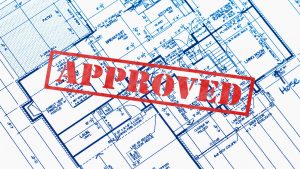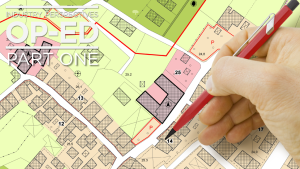Two high profile wood-framed condominium projects following changes to the Ontario Building code have flipped over to steel and concrete as the learning curve with lumber raises the bar.
Heartwood The Beach, at 1884 Queen St. E. and Woodbine Avenue, and Cabin Toronto at 45 Dovercourt Rd., were both touted for their innovative plans to use wood when they were announced in Spring 2016, following code changes in January 2015 allowing six storey wood framed buildings.
The latest hiccup for wood isn’t as much about its vulnerability to fire, it’s the steep learning curve, states Steven Street, a technical advisor to the Canadian Wood Council.
He says builders and developers are moving ahead with wood frame projects where it makes sense and that there’s a critical need to "educate, educate, educate."
"People really need to look at the best practices as defined by the Ministry of Municipal Affairs and Housing a couple of years ago," he says, noting there are some unique challenges to working with a wood-framed multi-storey project.
Still, the two Toronto condos first announced are not going to be wood framed and that’s down to a learning curve.
"Heartwood is now going to be concrete," says Richard Witt, principal of Quadrangle Architects, which designed the project. "It was a zoning issue. We would have had to cut a foot off each unit. Normally we’d do the re-zoning, but in this case it was already done and then sold to the developer."
At the other end of the city, Cabin will now be steel framed, says RAW Design architect Aaron Hendershott.
David Moses
Moses Structural Engineers Inc.
He says the initial hopes to use wood were dashed when the logistics around a zero lot line configuration were complicated by the skinny property orientation.
"With an infill in on a zero lot line there were complications because wood is a combustible material," he says, adding there were other issues because of the parking garage and the need to protect the combustible materials. "We needed to add lateral integrity with a steel moment frame and by the time the requirement for a concrete core and stairs and structural integrity were considered, there was more steel and cement than wood. It just didn’t make sense economically or from a design perspective to continue with a wood component, so it’s now all steel."
The setbacks affecting wood framed multi-storeys are raising eyebrows, says Larry Williams, executive director of the Steel Framing Industry Association (SFIA).
The SFIA has tracked fires pre- and post construction of wood framed buildings across North America, including Canada, noting it’s when material is laid down prior to installation that it’s the most vulnerable, he claims.
The next vulnerable stage is when the framing is up but the sprinklers aren’t installed and ignition comes from an incident such as a plumber’s or roofer’s torch.
One such example is the four-storey wood student residence in Kingston, Ont. that caught fire in December 2013, prompting a helicopter rescue of a crane operator stranded in his cab while the flames raged around him.
Some 18 months earlier fire destroyed the first of two six-storey wood framed buildings at the Remy Condominium in Richmond, B.C. during the drywall stage.
Last July, a fire at a $45-million, 83-unit six-storey wood framed condo complex in Dorchester, Boston, Mass. was blamed on a cast iron exhaust that was installed without the specified clearance from the framing. Just a week before, fire broke out at the 264-unit Edison on the Charles apartment complex under construction in Waltham, Boston, Mass. while a five-alarm fire in April in Washington at a complex under construction caused $39 million in damages.
This vulnerability calls for prudent planning and best practices, says Street. It means builders must have 24-7 security onsite during construction and builders insurance is between six to 10 times more expensive, he states.
Street adds insurance companies are still coming to terms with how to rate the risk and which practices will best mitigate those risks.
Despite the higher costs, the speed with which wood frames can be erected, especially if they are factory-built as prefabricated panels, has been a major consideration in construction projects. However, for wood, says Street, it means the premiums are paid over a shorter period of time, reducing the costs.
The question of combustion also rules out mid-rises for seniors residences or hotels, says Tony Di Giovanni of Bradley Metal Products in Concord, Ont.
"When you talk to builders all day like we do you find a lot of apprehension around six storey wood," he says. "Now, I clearly have an axe to grind here, but I really think steel ticks all the boxes for safety and performance."
There’s also the issue of cladding, says Di Giovanni, noting there’s still limited choice for wood because brick can only go three-storeys. There are also concerns about anchoring angle-iron to support masonry into wood generally.
That leaves cementitous board or steel cladding as alternatives for fire blocking.
It’s a challenge Quadrangle’s Witt has found a way around by using a thin cut limestone with a honey-combed backing to give it support and add interest to the commercial project at 80 Atlantic which is a wood frame with construction well underway. It is also the first wood-framed commercial structure in Toronto since the code changed.
Quadrangle is also the architect on Daniels FirstHome Markham Sheppard where 228 units will be built in three wood framed six-storey structures along with 100 townhomes on a 3.6-acre former Build Toronto site.
David Moses of Moses Structural Engineers Inc., one of the leading structural engineers in Ontario working with wood multi-storey structures, says there’s still a learning curve and that with skinny sites like the Cabin and other code requirements there just wasn’t anywhere left to use wood structurally.
"I think the developers and architects understand the material but perhaps the builders and contractors need to be more comfortable and understand it better," he says, noting profit margins are also tight in the city. "If there’s a five or 10 per cent saving they worry they could easily lose that if something doesn’t work out."
Outside of Toronto, which is constrained by tight lots, wood mid-rise is taking off because there’s a substantial cost saving, he says.
"It comes down to the right structure for any given site," Moses says. "I know the people making panelized wood components are booked solid and are extremely busy."
He adds the issue of cladding is also being resolved with full brick facings now going six storeys. Montreal’s Arbora, an eight-storey mass timber tower that sits on a concrete foundation and podium, is also getting a full size brick cladding. There are also plans for a 13-storey wood condo tower in Montreal called Origine.
British Columbia has permitted wood frame multi-storey for eight years, while Ontario changed their code recently, he says, so there’s some growth yet to come.
"In B.C. they’re moving to a sort of Wood 2.0," he says. "They’re using mass timber and longer space to give retail bigger open spaces on the ground floors and more post and beam."
Having options is the goal, not replacing steel or concrete, say wood proponents.
"Not everything perceived as going wood will become wood," says Street. "The point is that it makes a developer and builder consider alternatives to steel and wood. We’re going to win some and lose some."










Recent Comments
comments for this post are closed